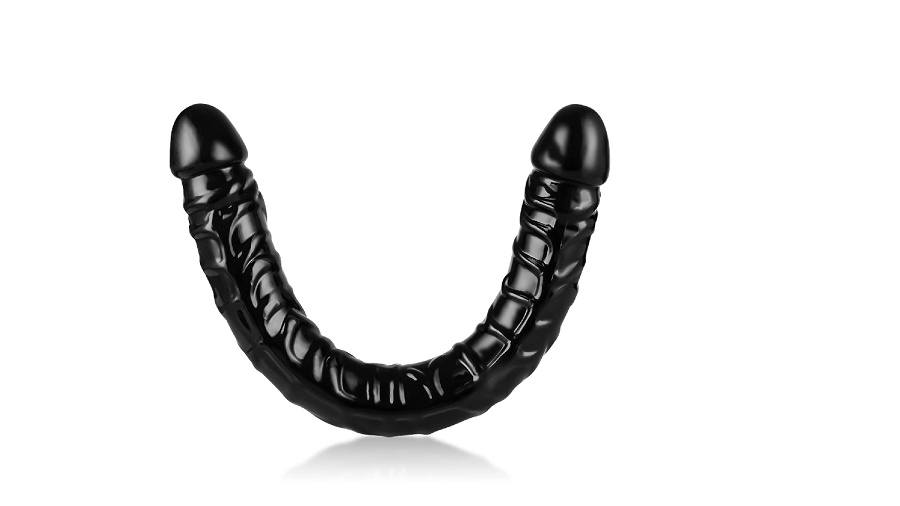by DNB editors.

Let’s be honest: the terms “Top” and “Bottom” are cute until they start feeling like job titles. Sure, they help describe what you’re into, but when labels turn into fixed rules, they do more harm than good.
Suddenly, instead of exploring pleasure, you’re managing expectations. Many couples seeking true intimacy hit a wall when rigid roles limit deeper exploration.
Enter versatile gay sex — a.k.a. DJ Flip-Switch! This isn’t just about yielding a little and then running back to the job title you put on your Grindr profile. True versatile sex is about rejecting identity politics and saying yes to more possibilities. Acknowledging your curiosity and giving yourself the freedom to explore.
Versatile sex fits our design
Having sex with someone with the same parts (kudos there, Tatiana!) can make things easier and smoother due to the familiarity of sensations. Call it reduced guesswork. For many cis gay men, shared anatomy can make coordination feel more intuitive, making it easier to read cues and make adjustments during role switching.
Shared anatomy offers a kind of erotic empathy: “I know what that stroke feels like, so I can adjust mine to match.” That’s not a guarantee — just a head start.
Remember:
• Sensation varies by body, mood, context and symmetry ≠ compatibility.
• Communication beats assumption every time.
7 Reasons Versatile Sex Hits Different
As already established in some of our earlier articles, nobody was born Top or Bottom. Some gay men stick with the top title due to pressures of masculinity. Others discover the magic of being served and stick with bottoming because, why not!
True versatility comes from curiosity — and it unlocks a whole new level of gay pleasure. Even Albert Einstein mentioned that curiosity was his only special talent.
🌊 Versatility unlocks new sensations — especially for people with prostates.
1. Shared agency
Both partners stay present, co-creating the experience instead of following rigid scripts.
2. Better communication
Switching roles encourages open talk about boundaries, comfort, and desire — strengthening consent and connection.
3. More variety
Role flexibility keeps sex dynamic and less likely to fall into routine.
4. Deeper empathy
Experiencing both roles builds trust and emotional closeness through mutual understanding.
5. Long-term adaptability
Versatility supports intimacy through life’s changes — injury, stress, ageing, shifting libido.
6. Extended pleasure
Switching can layer arousal — from pre-orgasm to prostate orgasm — creating what some call the “deluxe edition” of sex.
7. Less pressure
No fixed role means less performance anxiety and more freedom to explore what feels good.
Studies show that sexual role flexibility leads to lower anxiety and higher satisfaction (Moskowitz and Garcia, 20193; Rivas-Koehl, 20214). When both partners can give and receive, sex becomes mutual — not hierarchical.
Bottom line: Versatility trades expectation for experimentation. You’re not boxed into a role — you’re building a rhythm that fits the moment.
The Versatile Playbook: How to switch roles without killing the mood
No one wants the awkward “So… who’s topping now?” pause. Here’s how to make transitions smooth, sexy, and seamless.
a. Communicate and pre-negotiate:
Great sex starts with great communication — and that’s especially true if you plan to switch things up. A quick pitch like this works wonders: “Can I start with topping and then flip later—cool with you?” Honesty is important, but make room for the unexpected. Always remember that one bad encounter does not mean there won’t be future great ones. But don’t cheat.

b. Good warm-up makes flipping easier
Mutual oral sex, rimming or toy play can help equalise arousal, so switching feels more natural. Prepping together, if possible — cleaning up, trimming nails, back-rubbing— goes a long way in enhancing comfort and confidence.
Positions Perfect for Seamless Switching
| Position | Why It Works |
|---|---|
| Side-by-Side Spooning | Roll and flip without a full dismount — pure efficiency. |
| Edge-of-Bed Straddle | One partner repositions while the other stays put — minimal interruption. |
| Kneeling/Standing | Great for coordinated partners with pre-agreed cues. |
| Seated Chair or Couch | Back‑to‑back and face‑to‑face alternation—furniture gives stability, which makes transitions easier. |
Switching codes/cues
Signal when you want to switch. Ask your partner if they have been going on for a long time with no cue to switch. No need to switch if everyone is enjoying what they are currently doing. Pillows, a sturdy chair, and good-quality lube make transitions safer and more comfortable. Start slow; practice simple swaps first so you build a rhythm that feels natural for both partners.
Always pause briefly during a switch to confirm comfort and consent.
💡 Consent is ongoing — it can be changed or withdrawn at any point (CDC, 2023)1.
Best Lubricants for Switching
Keep two lubes handy — it’s not overkill; it’s logistics.
- Water-Based Lube: Safe with condoms and toys; easy cleanup.
- Silicone Lube: Ultra-long-lasting for body-to-body friction (just don’t mix with silicone toys).
- Pro Tip: If you think you’ve used enough lube, you probably haven’t (Planned Parenthood, n.d.)2.

Condoms and STI Prevention When Switching
Fluid play calls for fluid safety:
- If condomised, change condoms between roles: Especially when moving between anal and oral.
- Stay communicative: Regular STI testing, PrEP discussions, and honesty make switching safer and sexier (CDC, 2023).
Toys That Support Role-Switching
- Double-Ended Dildos or Strap Harnesses: Great for synchronised stimulation.
- Wearable Plugs or Hands-Free Toys: Keep both partners engaged during role reversal.

Gentle Prostate Stimulation
The prostate isn’t a button you smash; it’s a zone you explore. Use plenty of lube, slow movements, and clear feedback. The goal is pressure, not poking. Proper technique can lead to profound orgasms that feel full-body and lingering (Planned Parenthood, n.d.)2.
Avoiding Injury During Frequent Switching
Take breaks, reapply lube, and don’t ignore pain. Minor tears or muscle fatigue are real risks if you rush. As always: if it hurts, stop. Pain signals should prompt immediate stopping, per CDC guidelines on healthy sex (CDC, 2023)1.
Emotional Aftercare: The Secret Sauce of Great Sex 🫂
Role-fluid sex can strengthen intimacy in ways vanilla repetition can’t. Aftercare isn’t just post-sex niceness — it’s what turns casual pleasure into connection.
- Check In Afterwards: “What did you like most?” or “Want to try that again?” reinforces communication.
- Share Aftercare Duties: Cuddles, hydration, gentle talk — do what comforts each other.
- Build Emotional Safety: Couples who communicate about sex tend to have higher relationship satisfaction and trust (Rivas-Koehl, 2021)4.
Final Take: Find Your Flow
Being versatile isn’t about being half Top, half Bottom — it’s about being fully adaptable. Versatile sex works best when both partners feel safe, relaxed, and heard. That means lube, condoms, prep, and clear boundaries — not just for physical comfort, but emotional trust.
That said, versatile sex is not for everyone, so be honest up front about what turns you on and what doesn’t. Remember—good sex starts with good vibes.
What question or challenge about switching roles do you want answered next? Drop it in the comments below.
This guide is for informational purposes; consult a healthcare professional for personalised advice.
This article was jointly prepared by DNB editors. Have any topic suggestions for us to cover next? Contact us.
References
- Centers for Disease Control and Prevention. (2023). Safer sex and STD prevention. U.S. Department of Health & Human Services. https://www.cdc.gov/sti/prevention/index.html
- Planned Parenthood. (n.d.). Lube: Why it’s important and how to choose the right one. Planned Parenthood Federation of America. https://www.plannedparenthood.org/learn/sex-and-relationships/lube
- Moskowitz, D. A., & Garcia, C. P. (2019). Top, bottom, and versatile anal sex roles in same-sex male relationships: Implications for relationship and sexual satisfaction. The Journal of Sex Research, 56(4-5), 566-575. https://doi.org/10.1080/00224499.2018.1468854
- Rivas-Koehl, M. (2021). Top, bottom, or vers? Sexual satisfaction and masculine conformity as correlates of queer men’s use of sexual positional identities [Master’s thesis, Texas Tech University]. TTU DSpace Repository. https://ttu-ir.tdl.org/items/7f1c2033-dc70-4a44-8a63-36f5bcf43bb4


